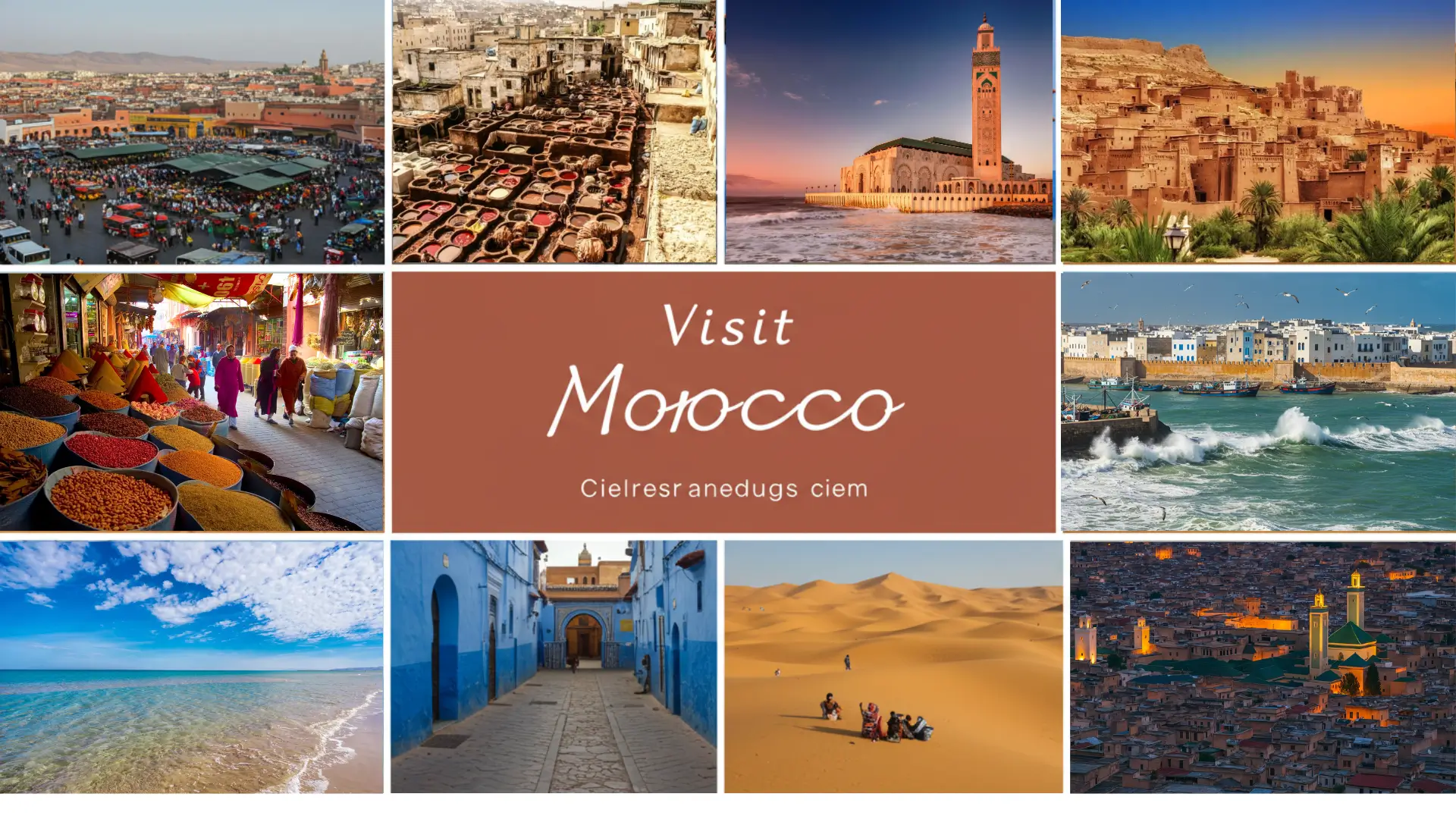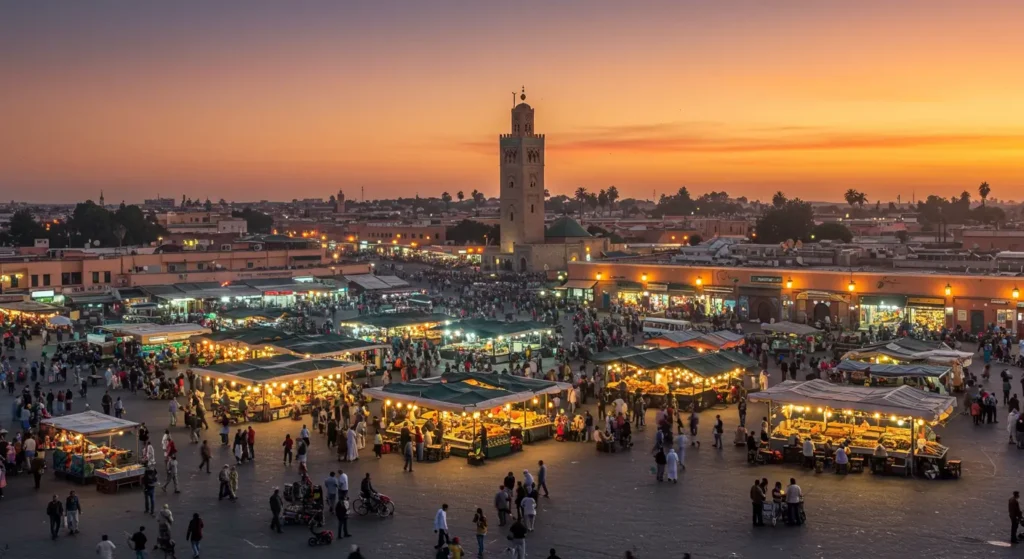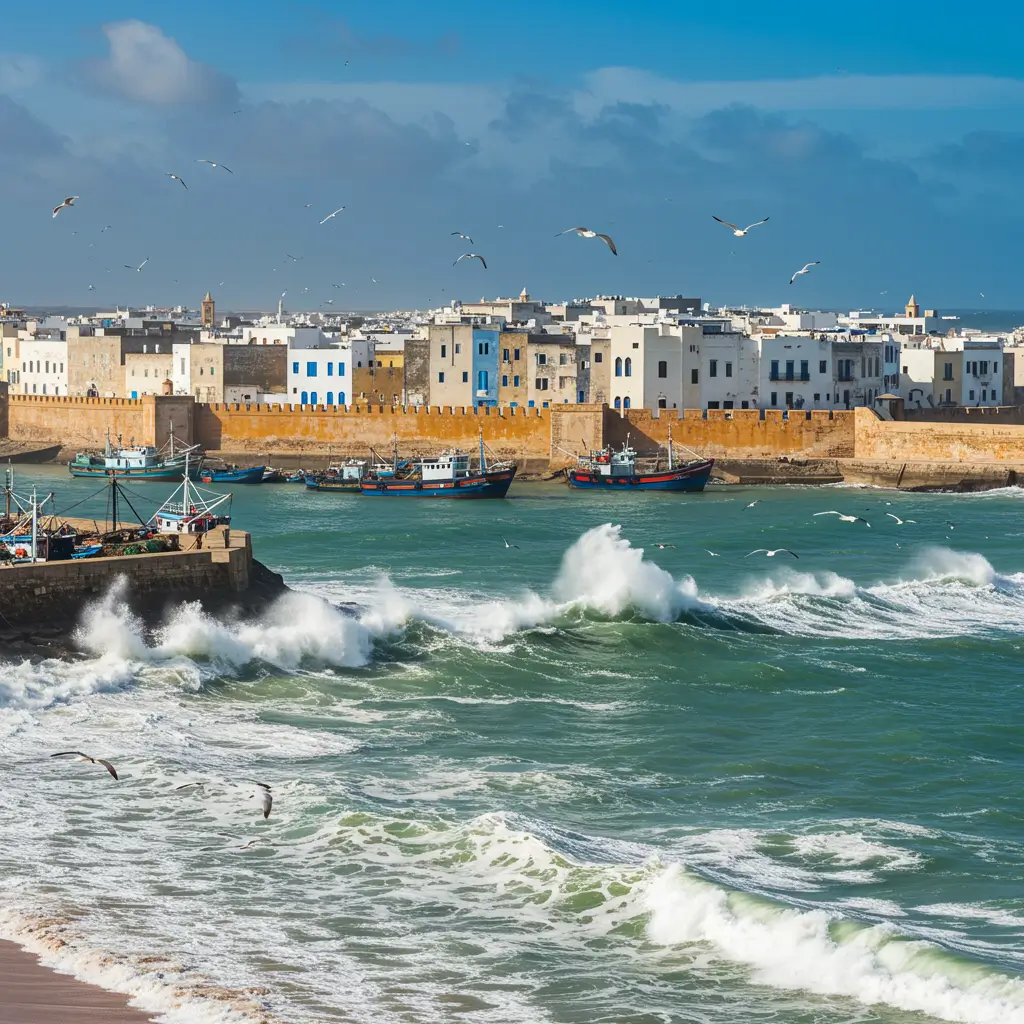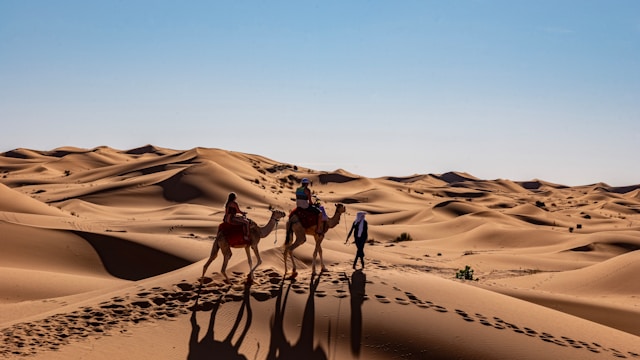Best Places to Visit in Morocco: The Ultimate Travel Guide

Morocco captivates travelers with its intoxicating blend of ancient medinas, towering mountains, sweeping deserts, and vibrant coastal towns. This North African gem offers an extraordinary tapestry of experiences—from navigating bustling souks filled with artisanal treasures to sipping mint tea in tranquil riads and trekking through dramatic landscapes that have served as backdrops for countless films.
This comprehensive guide will take you through Morocco’s most spectacular destinations, providing expert insights, practical travel tips, and immersive experiences to help you craft your perfect Moroccan adventure. Whether you’re drawn to imperial cities, coastal escapes, mountain retreats, or desert expeditions, Morocco offers unforgettable experiences for every type of traveler.
Methodology
Our selection of Morocco’s best destinations is based on a combination of visitor popularity, cultural significance, and unique experiences. We’ve consulted local guides, tourism data, and gathered insights from experienced travelers to provide a well-rounded view of what makes each location special. Our recommendations aim to showcase Morocco’s diverse landscapes and rich cultural heritage while providing practical advice for different travel styles.
Marrakech: The Red City’s Vibrant Soul

Marrakech is the beating heart of Morocco, where ancient traditions and modern luxuries coexist within ochre-colored walls.
Why Visit?
- Iconic Djemaa el-Fna Square – One of Africa’s most famous public spaces that transforms from day to night
- Labyrinthine Medina – A UNESCO World Heritage site filled with treasures at every turn
- World-Class Riads – Experience traditional Moroccan homes converted into stunning boutique accommodations
- Exceptional Gardens – From Majorelle to Menara, oases of calm amid the urban buzz
- Culinary Adventures – From street food to sophisticated restaurants showcasing Morocco’s diverse flavors
Top Things to Do
- Explore Djemaa el-Fna – Immerse yourself in this dynamic square filled with storytellers, snake charmers, and food stalls as day turns into night.
- Get Lost in the Souks – Navigate the maze-like markets specializing in everything from spices and leather to textiles and metalwork.
- Visit Bahia Palace – Marvel at the intricate tilework, carved cedar, and painted ceilings of this 19th-century masterpiece.
- Stroll Through Jardin Majorelle – Discover the electric blue villa and exotic garden once owned by Yves Saint Laurent.
- Relax in a Hammam – Experience traditional Moroccan bathing rituals at either a local establishment or luxury spa.
Insider Tip
Visit Djemaa el-Fna around 4 PM to watch it transform from a relatively quiet square to a bustling night market. For the best views, head to one of the rooftop cafés (Café de France is popular) an hour before sunset, order a mint tea, and watch the spectacle unfold below.
Best For
Culture enthusiasts, photographers, shoppers, and first-time visitors to Morocco. Marrakech offers the quintessential Moroccan experience that combines sensory stimulation with cultural immersion.
Getting There & Around
Most international visitors arrive via Marrakech Menara Airport, which has connections to major European cities. Within the city, navigate the medina on foot, use petit taxis for short trips, or horse-drawn carriages (calèches) for a traditional experience.
Suggested Stay Duration
3-4 days minimum to experience the major attractions and soak in the atmosphere, with extra time for day trips to the Atlas Mountains or for relaxation.
Fes: Morocco’s Cultural Capital

Fes is the intellectual and cultural heart of Morocco, housing the world’s oldest continually operating university and the largest car-free urban area worldwide.
Why Visit?
- Authentic Medieval Atmosphere – The most complete medieval city in the Arab world
- Unrivaled Craftsmanship – Home to master artisans practicing centuries-old techniques
- Culinary Excellence – Considered Morocco’s food capital with distinctive regional specialties
- Historical Significance – Morocco’s first capital with over 1,200 years of rich history
- Less Touristic – More authentic experience compared to Marrakech
Top Things to Do
- Wander Through Fes el-Bali – Get purposefully lost in the 9,000+ alleyways of the UNESCO-listed old medina.
- Visit the Tanneries – The iconic Chouara Tannery offers a glimpse into traditional leather-making methods unchanged since medieval times.
- Explore Al-Qarawiyyin – Founded in 859, it’s the world’s oldest operating university and houses a magnificent mosque and library.
- Attend a Cooking Class – Learn to prepare authentic Fassi dishes, known for their refined flavors and techniques.
- Shop for Artisanal Crafts – From blue ceramics to intricate metalwork, Fes offers Morocco’s finest handicrafts.
Insider Tip
When visiting the tanneries, go in the morning for the best light for photos. Don’t accept the first “guide” who approaches you; instead, find a leather shop with a terrace view and negotiate entrance—they’ll expect you to browse their goods afterward, but purchase is optional.
Best For
History buffs, authentic culture seekers, food enthusiasts, and travelers wanting to experience traditional Morocco with fewer tourist crowds.
Getting There & Around
Fes-Saïs Airport connects to major European cities. Alternatively, take a train from Casablanca, Marrakech, or Rabat. Within the medina, walking is the only option (with occasional help from porters), while petit taxis serve the modern city.
Suggested Stay Duration
2-3 days to explore the medina thoroughly and experience the city’s cultural offerings.
Chefchaouen: The Blue Pearl

Nestled in the Rif Mountains, Chefchaouen enchants visitors with its striking blue-washed buildings that create a dream-like atmosphere.
Why Visit?
- Photogenic Blue Medina – Every corner offers Instagram-worthy views
- Mountain Setting – Spectacular location with hiking opportunities in the surrounding hills
- Relaxed Atmosphere – A laid-back vibe that contrasts with Morocco’s imperial cities
- Unique Shopping – Distinctive local handicrafts including woven blankets and handmade soaps
- Cultural Blend – Fascinating mix of Moroccan and Andalusian influences
Top Things to Do
- Photograph the Blue Streets – Wander through the azure alleyways, especially in the morning light or late afternoon.
- Hike to the Spanish Mosque – Enjoy panoramic views of the blue city, especially stunning at sunset.
- Explore Kasbah Museum – Visit the 18th-century fortress and ethnographic museum in the town center.
- Shop for Local Crafts – Browse the medina for handwoven textiles, mountain herbs, and natural soaps.
- Experience Cafe Culture – Relax in Plaza Uta el-Hammam, sampling local goat cheese and mint tea.
Insider Tip
For the best photos without crowds, explore the residential areas farther from the main plaza before 9 AM. The bluest streets are regularly repainted and are often in the northeast section of the medina.
Best For
Photographers, relaxation seekers, hikers, and travelers looking to experience a quieter side of Morocco away from the hustle and bustle.
Getting There & Around
No direct flights; most visitors arrive by bus from Tangier (2 hours), Fes (4 hours), or with a rental car. The medina is pedestrian-only, with the town small enough to navigate entirely on foot.
Suggested Stay Duration
1-2 days is sufficient for most visitors, though those seeking relaxation may wish to stay longer.
Essaouira: Atlantic Coastal Charm

This fortified coastal town balances historical significance with laid-back beach vibes, attracting artists, water sports enthusiasts, and those seeking respite from inland heat.
Why Visit?
- Picturesque Fortified Port – UNESCO-listed seaport with Portuguese architecture
- Thriving Arts Scene – Galleries and workshops scattered throughout the medina
- Fresh Seafood – Some of Morocco’s best seafood served directly from the harbor
- Perfect Climate – Refreshing Atlantic breezes make it ideal even in summer
- Water Sports Paradise – World-renowned for windsurfing and kitesurfing
Top Things to Do
- Walk the Ramparts – Explore the impressive 18th-century sea wall fortifications, recognizable from Game of Thrones.
- Browse the Souk – Shop for locally crafted woodwork, textiles, and art in a relaxed atmosphere with less pressure than other Moroccan markets.
- Visit the Harbor – Watch the iconic blue boats return with the day’s catch and sample fresh seafood from the portside grills.
- Try Watersports – Take advantage of the consistent winds for world-class windsurfing or kitesurfing.
- Explore Gnaoua Culture – Time your visit for the famous Gnaoua World Music Festival (usually in June) or visit cultural centers year-round.
Insider Tip
For an exceptional seafood experience, skip the touristy harbor stalls and head to the fish market in the morning. Purchase your selection and take it to a nearby small restaurant where they’ll cook it for a small fee.
Best For
Beach lovers, water sports enthusiasts, artists, musicians, and travelers seeking a more relaxed Moroccan experience with European influences.
Getting There & Around
Essaouira Airport has limited connections; most visitors arrive via a 2.5-hour bus ride or private transfer from Marrakech. The compact medina is entirely walkable, with bicycles available for exploring the broader region.
Suggested Stay Duration
2-3 days is ideal, more if you’re into water sports or seeking creative inspiration.
Sahara Desert: Magical Desert Experience

The golden dunes of Erg Chebbi and Erg Chigaga offer Morocco’s quintessential desert experience, where silence and stars create unforgettable memories.
Why Visit?
- Iconic Saharan Landscape – Towering sand dunes stretching as far as the eye can see
- Berber Cultural Immersion – Authentic interactions with desert nomadic traditions
- Spectacular Night Skies – Unparalleled stargazing away from light pollution
- Adventure Activities – Camel treks, sandboarding, and 4×4 excursions
- Luxury Desert Camps – Experience comfortable glamping in the wilderness
Top Things to Do
- Camel Trek at Sunset – Ride camels over the dunes as the setting sun paints the landscape gold and rose.
- Stay in a Desert Camp – Spend the night in a traditional or luxury camp under the stars.
- Experience Berber Music – Enjoy fireside drumming and songs performed by local musicians.
- Try Sandboarding – Slide down the massive dunes on rented boards for an adrenaline rush.
- Visit Desert Oases – Discover pockets of green life sustained by underground water sources.
Insider Tip
For a more authentic experience, choose Erg Chigaga over the more accessible Erg Chebbi. It requires a longer journey but rewards with fewer tourists and more pristine dunes. Splurge on a luxury camp with private bathroom facilities for comfort without sacrificing the experience.
Best For
Adventure seekers, photographers, romantic travelers, and anyone seeking a profound connection with nature and traditional cultures.
Getting There & Around
Access to Merzouga (for Erg Chebbi) or M’hamid (for Erg Chigaga) is typically arranged through tour operators from Marrakech, Fes, or Ouarzazate. The journey itself—through the Atlas Mountains and pre-Saharan landscape—is part of the experience.
Suggested Stay Duration
1-2 nights in the desert itself, plus travel time (often incorporated into a multi-day tour of southern Morocco).
Casablanca: Modern Morocco
Morocco’s largest city and economic powerhouse showcases the country’s contemporary side while still offering important historical attractions.
Why Visit?
- Hassan II Mosque – One of the world’s largest mosques and a masterpiece of modern Islamic architecture
- Art Deco Architecture – The world’s greatest collection of Mauresque (Moorish Art Deco) buildings
- Cosmopolitan Atmosphere – Morocco’s most progressive and business-oriented city
- Upscale Shopping – Modern malls and boutiques offering international and local brands
- Vibrant Food Scene – From traditional Moroccan to cutting-edge fusion cuisine
Top Things to Do
- Tour Hassan II Mosque – One of few mosques in Morocco open to non-Muslims, featuring breathtaking craftsmanship and ocean views.
- Stroll the Corniche – Enjoy the beachfront promenade lined with restaurants, clubs, and swimming pools.
- Explore the Old Medina – Though not as impressive as other Moroccan cities, it offers an authentic local experience.
- Visit Morocco Mall – One of Africa’s largest shopping centers, complete with an aquarium and indoor fountain shows.
- Discover Art Deco Architecture – Take a self-guided walking tour of the city center’s distinctive buildings from the 1930s.
Insider Tip
For a taste of local Casablanca life, visit the bustling Central Market in the morning, then head to Sqala in the old medina for lunch. In the evening, experience the upscale side of the city at Ain Diab or the trendy restaurants in the Gauthier neighborhood.
Best For
Business travelers, architecture enthusiasts, shoppers, and those seeking a more contemporary Moroccan experience with fewer tourists.
Getting There & Around
Mohammed V International Airport is Morocco’s main gateway with connections worldwide. Within the city, use petit taxis, the modern tram system, or ride-sharing apps which are widely available.
Suggested Stay Duration
1-2 days is sufficient for most travelers, often at the beginning or end of a broader Moroccan itinerary.
Rabat: The Elegant Capital
Morocco’s political capital combines administrative importance with cultural heritage, offering uncrowded attractions and a refined atmosphere.
Why Visit?
- UNESCO World Heritage Sites – Including Kasbah of the Udayas and Hassan Tower
- Clean and Organized – Well-maintained city with efficient public transportation
- Cultural Institutions – Exceptional museums and galleries showcasing Moroccan heritage
- Oceanfront Setting – Beautiful beaches and coastal areas within the city
- Royal Presence – Home to the royal palace and governmental institutions
Top Things to Do
- Explore Kasbah of the Udayas – Wander through the picturesque blue and white streets of this fortress overlooking the Atlantic.
- Visit Hassan Tower – Marvel at the unfinished 12th-century minaret and the modern Mausoleum of Mohammed V opposite.
- Discover Chellah – Explore the atmospheric ruins combining Roman and medieval Islamic elements.
- Tour the Royal Palace – While the interior is closed to the public, the impressive exterior and changing of the guard ceremony are worth seeing.
- Relax in Andalusian Gardens – Enjoy meticulously maintained Spanish-influenced gardens adjacent to the Kasbah.
Insider Tip
The best time to visit Hassan Tower is late afternoon when the golden light enhances the sandstone structure. Afterward, walk to the nearby Café Maure in the Kasbah for mint tea with views over the river mouth where the Bou Regreg meets the Atlantic.
Best For
History enthusiasts, those interested in contemporary Moroccan politics and culture, and travelers seeking a more relaxed urban experience than Marrakech or Casablanca.
Getting There & Around
Rabat-Salé Airport serves limited destinations; most visitors arrive via train from Casablanca (1 hour) or other major cities. Within Rabat, the efficient tram system connects major sights, supplemented by petit taxis.
Suggested Stay Duration
1-2 days allows visitors to see the major attractions at a comfortable pace.
Beyond the Top Destinations
Moulay Idriss & Volubilis
This perfect pairing combines Morocco’s holiest town with North Africa’s best-preserved Roman ruins.
The sacred hilltop town of Moulay Idriss, named after Morocco’s founding father, offers authentic cultural immersion just an hour from Fes. Nearby, the archaeological site of Volubilis features impressive mosaics, triumphal arches, and columns testifying to Rome’s northernmost African outpost.
Taghazout & Paradise Valley
Morocco’s premier surfing destination offers laid-back beach vibes, excellent waves for all skill levels, and nearby Paradise Valley—a stunning oasis of natural pools nestled in the Atlas foothills. Popular with surfers and yoga enthusiasts, Taghazout provides a different perspective on coastal Morocco than Essaouira.
Ouarzazate & Aït Benhaddou
Known as “The Door of the Desert,” Ouarzazate serves as the gateway to the Sahara and Morocco’s film industry hub, with massive studios producing everything from Game of Thrones to Gladiator. Nearby, the UNESCO-listed ksar (fortified village) of Aït Benhaddou presents one of Morocco’s most spectacular examples of earthen clay architecture, dramatically staged along an ancient caravan route.
High Atlas Mountains
The dramatic mountain range separating northern Morocco from the Sahara offers spectacular trekking opportunities, from gentle day hikes to challenging multi-day expeditions including Jebel Toubkal, North Africa’s highest peak. Traditional Berber villages dot the valleys, providing authentic cultural experiences far removed from urban Morocco.
Tangier
Once an international zone with a notorious reputation, Tangier has undergone a remarkable renaissance. This strategic port where the Mediterranean meets the Atlantic now offers sophisticated cultural attractions, renovated historic districts, and a fascinating blend of European and African influences that has long attracted artists and writers.
Practical Planning
Best Time to Visit Morocco
Peak Season (March-May, September-November): Ideal weather with comfortable temperatures across the country. Expect higher prices and advance bookings recommended.
Summer (June-August): Hot and dry inland (often exceeding 100°F/38°C in Marrakech and the desert), but perfect along the Atlantic coast. Consider focusing on Essaouira, Rabat, and mountain areas.
Winter (December-February): Mild in coastal regions and cities but cold in mountains (with snow possible) and desert nights. Lower tourist numbers mean better deals, though some desert camps reduce operations.
Regional Considerations:
- Desert: Avoid summer months unless you’re comfortable with extreme heat.
- Mountains: Best April-October; winter brings snow and cold temperatures.
- Coast: Pleasant year-round; summer brings refreshing breezes.
Getting Around Morocco
Trains: Morocco’s excellent rail network connects major cities with comfortable, affordable service. First-class tickets recommended for guaranteed seats.
Buses: Both luxury coaches (CTM, Supratours) and local services available. Luxury options recommended for longer journeys.
Grand Taxis: Shared Mercedes vehicles operate between towns on fixed routes—economical but can be crowded.
Car Rental: Offers flexibility for exploring rural areas, but navigating cities can be challenging. International driving permit recommended.
Domestic Flights: Limited but useful for covering long distances (Marrakech to Tangier, for example) when time is short.
Sample Itineraries
7-Day Imperial Cities Tour
- Days 1-2: Casablanca & Rabat
- Days 3-4: Fes & Meknes
- Days 5-7: Marrakech
10-Day Coast & Culture
- Days 1-3: Marrakech
- Days 4-5: Essaouira
- Days 6-7: Casablanca & Rabat
- Days 8-10: Tangier & Chefchaouen
14-Day Grand Morocco Circuit
- Days 1-3: Marrakech
- Days 4-5: High Atlas & Aït Benhaddou
- Days 6-7: Sahara Desert
- Days 8-10: Fes & Volubilis
- Days 11-12: Chefchaouen
- Days 13-14: Rabat & Casablanca
Essential Travel Tips
- Language: Arabic and Berber are official languages, but French is widely spoken in urban areas and tourist zones. English is increasing but basic French phrases help.
- Currency: The Moroccan dirham (MAD) is a closed currency—exchange money upon arrival and before departure. ATMs widely available in cities.
- Bargaining: Expected in souks and with taxis. Start around 50-60% below the asking price and maintain a friendly attitude.
- Dress Code: Conservative dress recommended, especially outside tourist areas. Women should cover shoulders and knees; men should avoid shorts in religious sites.
- Photography: Always ask permission before photographing people. Expect to pay a small tip if granted.
- Tipping: Generally expected—10% in restaurants, small amounts for guides and service staff.
- Water: Stick to bottled water; avoid ice in remote areas.
Frequently Asked Questions
Is Morocco safe for tourists?
Morocco is generally safe for tourists with normal precautions. Like most destinations, petty theft can occur in crowded areas, so remain vigilant with belongings. Women travelers may experience unwanted attention and should consider joining tours or traveling with companions in remote areas.
Do I need a visa to visit Morocco?
Many nationalities including US, EU, UK, Australian, and Canadian citizens can enter Morocco visa-free for stays up to 90 days. Check specific requirements for your passport well before travel.
What currency should I use in Morocco?
The Moroccan dirham (MAD) is the official currency. Major cities accept credit cards, but cash is essential for smaller establishments and rural areas. Exchange money at airports, banks, or authorized bureaus rather than on the street.
How much does a trip to Morocco cost?
Morocco accommodates various budgets: budget travelers can manage on $30-50 per day, mid-range travelers should plan for $100-150 daily, while luxury experiences can cost $250+ per day. Food is generally inexpensive, while quality accommodations and guided tours comprise the largest expenses.
What should I pack for Morocco?
Pack lightweight, modest clothing with layers for temperature variations. Essential items include comfortable walking shoes, a hat, sunscreen, modest swimwear for coastal areas, and a light jacket or sweater for evening temperature drops. Women should bring a scarf for visiting religious sites.
How do I handle the attention from touts and vendors?
A firm but polite “La, shukran” (No, thank you) works well. Avoiding eye contact and continuing to walk demonstrates you’re not interested. For persistent vendors, entering a shop or cafe can provide relief. Remember that tourism is vital to the economy—patience and understanding go a long way.
Conclusion
Morocco offers an unparalleled blend of experiences that satisfy every traveler’s desires—from the sensory explosion of ancient medinas to the serene vastness of the Sahara, from the refreshing Atlantic coastline to the majestic peaks of the Atlas Mountains. This diversity within a relatively compact country makes Morocco an ideal destination for both first-time visitors to Africa and experienced travelers seeking authentic cultural immersion.
As you plan your Moroccan adventure, remember that the country rewards those who embrace its rhythms and traditions. Take time to sit in cafés, accept cups of mint tea when offered, and wander without rigid schedules. The most memorable experiences often come from unexpected encounters and discoveries beyond the guidebook highlights.
Whether you’re haggling in Marrakech’s souks, watching the blue hour descend on Chefchaouen, or riding camels across golden dunes, Morocco will leave an indelible impression that calls you back time and again. Start planning your unforgettable Moroccan journey today!
What aspect of Morocco are you most excited to experience? Share in the comments below!
